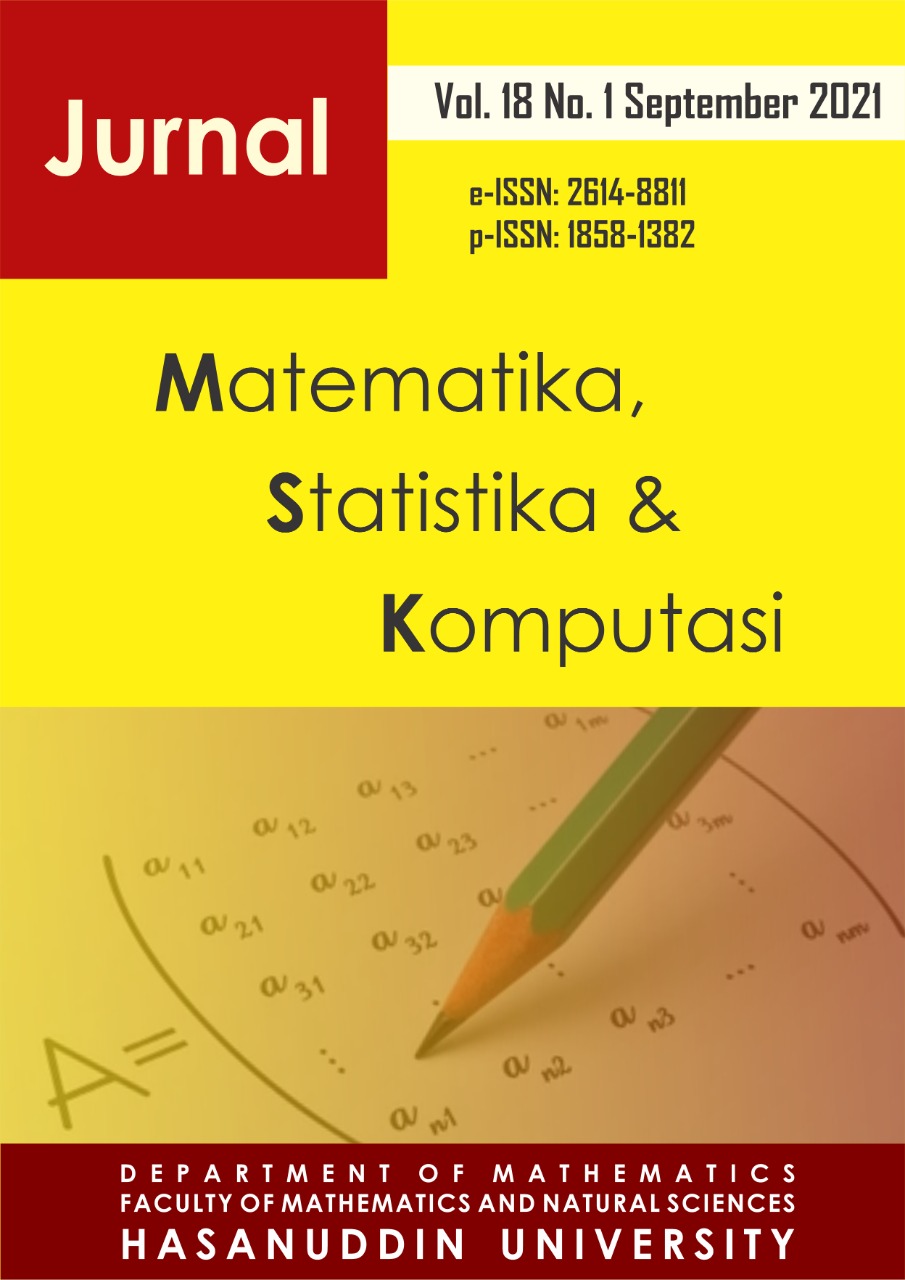Covid-19 Patient Mortality Risk Classification Using Bayesian Binary Logistic Regression
DOI:
https://doi.org/10.20956/j.v18i1.14268Keywords:
Logistic Regression, Bayesian, Covid-19Abstract
At the end of 2019 the world was shocked by a new disease caused by SARS-CoV-2 (Severe Acute Respiratory Syndrome Coronavirus 2). The disease is called Covid-19 (Coronavirus Disease). The mortality rate due to disease is increasing every day. In Indonesia as of April 2021, confirmed Covid-19 patients who died reached 42,530 patients, seeing the high mortality rate of Covid-19 patients so it needs to be studied further so that the risk of death of these Covid-19 patients can be minimized. This research utilizing binary logistic regression with Bayesian method parameter estimation. In this study, the predictor variables used were in the form of categories that each category in the predictor variables was assumed to have the same risk of death risk of Covid-19 patients. The results of this study indicate that the number of comorbids has a significant effect on the risk of death of Covid-19 patients, the more the number of comorbids suffered by the patient, the higher the risk of death of the patient. The accuracy of this method in classifying data is 84.68%.Downloads
References
Bergerud, W. A., 1996. Introduction to Logistic Regression Models with Worked Forestry Examples Biometrics Information Handbook No. 7. Victoria British Columbia: Ministry of Forests.
Box, G.E.P. dan Tiao, G.C., 1973. Bayesian Inference in Statistical Analysis. Philippines: Addision Wesley Company. Inc.
Harlan, J., 2018. Analisis Regresi Logistik. Jakarta : Gunadarma.
Hindayani, W. R., 2020. Faktor-faktor Risiko yang Berhubungan dengan Covid-19: Literatur Review. Jurnal Untuk Masyarakat Sehat (JUKMAS), Vol.4, No. 2, pp.120-134.
Khairiyah, R., Maiyastri dan Diana, R., 2016. Perbandingan Metode Kuadrat Terkecil dan Metode Bayes Pada Model Regresi Linier dengan Galat yang Autokorelasi. Jurnal Matematika UNAND, Vol.7, No. 1, pp. 115-124.
NN. 2020. Data Penyebaran COVID-19. https://covid19.go.id/ (diakses pada 14 April 2021).
Ntzoufras, I., 1973. Bayesian Modelling Using WinBUGS. Greece: Departement of Statistics Athens University of Economics and Bussines.
Siagian, T. H., 2020. Mencari Kelompok Berisiko Tinggi Terinfeksi Virus Corona dengan Discourse Network Analysis. Jurnal Kebijakan Kesehatan Indonesia (JKKI), Vol. 9, No. 2, pp. 98-106.
Susilo, A.,Rumende, C.M., Pitoyo, C.W., Santoso, W.D., Yulianti, M., Herikurniawan, Sinto, R., Singh, G., Nainggolan, L., Nelwan, E.J., Chen, L.K., Widhani, A., Wijaya, E., Wicaksana, B., Maksum, M., Annisa, F., Jasirwan, C.O. dan Yunihastuti, E., 2020. Coronavirus Diases 2019: Tinjauan Literatur Terkini. Jurnal Penyakit Dalam Indenesia, Vol. 7, No. 1, pp. 45-67.
Walpole, R.E., Myers, S.L. dan Ye, K., 2011. Probability & Statistics for Engineers & Scientists Ninth Edition. United State of America: Pearson Education, Inc.
Yuliana, 2020. Coronavirus Diases (Covid-19) : Sebuah Tinjauan Literatur. Wellness and Healty Magazine, Vol. 2 No. 1, pp. 187-192.
Downloads
Published
How to Cite
Issue
Section
License
Copyright (c) 2021 Author and publisher

This work is licensed under a Creative Commons Attribution 4.0 International License.

This work is licensed under a Creative Commons Attribution 4.0 International License.
Jurnal Matematika, Statistika dan Komputasi is an Open Access journal, all articles are distributed under the terms of the Creative Commons Attribution License, allowing third parties to copy and redistribute the material in any medium or format, transform, and build upon the material, provided the original work is properly cited and states its license. This license allows authors and readers to use all articles, data sets, graphics and appendices in data mining applications, search engines, web sites, blogs and other platforms by providing appropriate reference.








